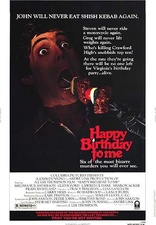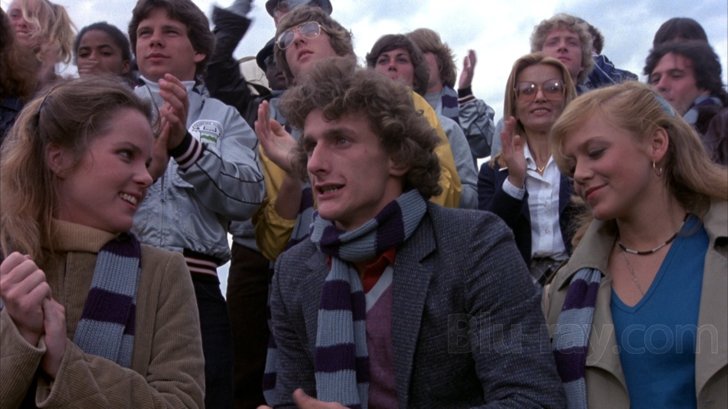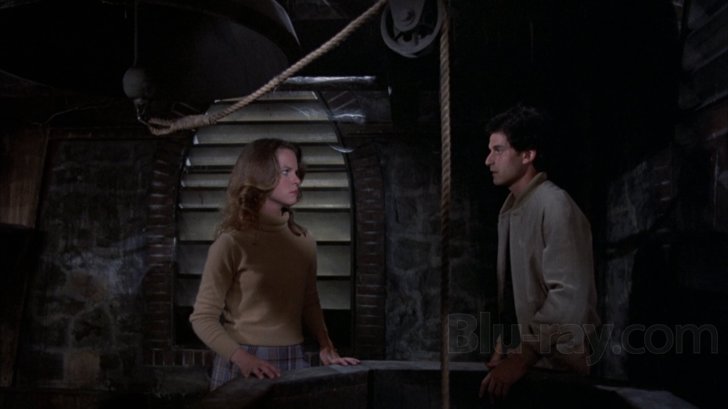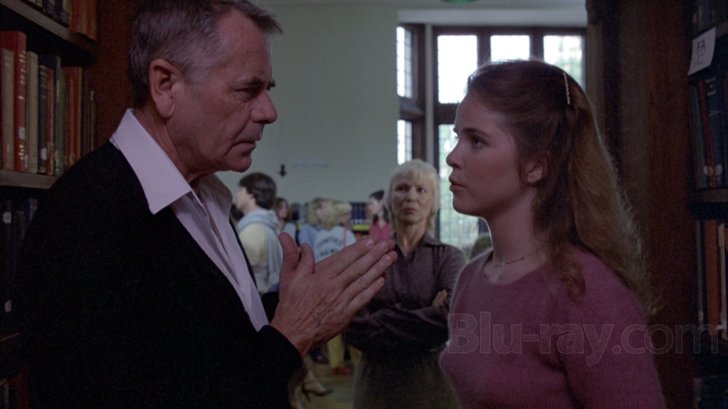Happy Birthday to Me Blu-ray Movie
HomeHappy Birthday to Me Blu-ray Movie 
Mill Creek Entertainment | 1981 | 111 min | Rated R | No Release Date
Price
Movie rating
6.5 | / 10 |
Blu-ray rating
| Users | 0.0 | |
| Reviewer | 3.0 | |
| Overall | 3.0 |
Overview
Happy Birthday to Me (1981)
Girl student wants to be part of the school’s most popular clique. But somebody has begun killing the group’s members. Could a deadly accident from her past be connected to the brutal killings?
Starring: Melissa Sue Anderson, Glenn Ford, Lawrence Dane, Sharon Acker, Frances Hyland (II)Director: J. Lee Thompson
| Horror | Uncertain |
| Thriller | Uncertain |
| Mystery | Uncertain |
Specifications
Video
Video codec: MPEG-4 AVC
Video resolution: 1080p
Aspect ratio: 1.78:1
Original aspect ratio: 1.85:1
Audio
English: DTS-HD Master Audio 5.1 (48kHz, 24-bit)
Subtitles
English SDH
Discs
50GB Blu-ray Disc
Single disc (1 BD)
Playback
Region A (B, C untested)
Review
Rating summary
| Movie | 3.0 | |
| Video | 3.5 | |
| Audio | 3.0 | |
| Extras | 0.0 | |
| Overall | 3.0 |
Happy Birthday to Me Blu-ray Movie Review
Party Till You're Dead
Reviewed by Michael Reuben April 7, 2013One's reaction to Happy Birthday to Me (hereafter, "HBtM") no doubt depends on what one wants from a slasher film. If you're looking for elaborately staged executions of scantily clad and misbehaving teens, the film will disappoint. The deaths are widely spaced, and the buckets of blood that director J. Lee Thompson reportedly tossed around the set had to be toned down to obtain an R rating. (Copies of the uncut version are rumored to exist for those willing to search and pay the price.) If you crave a tautly edited, unrelenting turn of the suspenseful screws à la John Carpenter's Halloween, HBtM can't deliver that either. It has way too much plot, and its suspense rises and falls in waves as it gradually reveals its story in layers. What HBtM has going for it—and why I consider it a minor classic—is a distinctively loopy originality, a kind of determination, just one year after the original Friday the 13th and three years after Halloween, not to fall into the slasher formula that would generate so many routine sequels for the next two decades and well into the next century. Instead, director Thompson tried to make a slasher movie as if it were the kind of thriller with which he'd had such success when he made the original Cape Fear nineteen years earlier. Admittedly, a somewhat different skill set was required, especially with the credibility-straining script penned by John Saxton (who wrote the original story) and several other scribes, and the last-minute decision to change the ending after most of principal photography had been completed. But Thompson, no matter how cheesy some of his projects turned out to be, remained an old-fashioned storyteller. He always tried to ensure that his characters had reasons for their actions, no matter how convoluted they might be. With the passage of time, it's hard to replicate the kick that contemporary audiences experienced from seeing Melissa Sue Anderson in the lead role, because she was then at the height of her fame as TV's beloved Mary on Little House on the Prairie. As the film progressed and suspicion grew that her character might just be a killer (because so many other suspects had been eliminated), the cognitive dissonance either made viewers ill or, depending on one's predilection, gleeful. (I was among the latter.)

At the elite Crawford Academy run by a stern headmistress, Mrs. Patterson (Frances Hyland), the super-elite clique is known as "the Top Ten". The newest member is Virginia Wainwright (Anderson), or "Ginny", who attended Crawford briefly a few years earlier, though no one remembers her. Ginny's departure from her initial enrollment had something to do with the death of her mother, whose grave she visits regularly, despite the protest of her father (Lawrence Dane) that it's an unhealthy obsession. Ginny herself suffered severe head trauma when her mother died, but she can't recall the event. Only through risky, experimental brain surgery was she brought back to an active and normal life. To aid in her adjustment, Ginny regularly sees a therapist, Dr. David Faraday (Glenn Ford, who was accused at the time of slumming but undeniably adds heft to the cast). The essential action of HBtM is the steady and unexplained disappearance of members of the Top Ten. Some of the absences, like the opening sequence involving a terrified Bernadette O'Hara (Lesleh Donaldson), who never does make it to a gathering at the Silent Woman Tavern, are the real thing, but only the audience and the unseen killer know it. Some of them are not. Thompson keeps switching his camera to the classic stalker's point of view, but it gradually becomes clear that you can't always trust what you see. Some of those stalker shots turn out to be deadly, others not so much. About two thirds of the way through the film, the killer's identity is apparently revealed. But maybe the killer we see isn't the person calling the shots. Meanwhile, as Ginny continues her visits with David, she gradually recovers her past, including the gruesome procedures that both saved her life and just possibly turned her into someone else. In keeping with the film's title, everything comes to a conclusion on Ginny's eighteenth birthday, when everyone has been invited to a party in her honor. Some viewers have complained that HBtM is too long, but my view is that it's the apparent digressions that make the movie (unless, of course, you're a hardcore gore fan, in which case you're watching the wrong film). Elements like the elaborate attention paid to the taxidermy pursuits of Alfred (Jack Blum), a Top Ten member with a pet mouse and an intense fixation on Ginny, or the lengthy climb up the school chapel's bell tower with Rudi (David Eisner), complete with impressions of Charles Laughton's Hunchback (and other horror classics), or the extended action sequence involving a game of "chicken" over a draw bridge, or even the motorcycle race in which exchange student Etienne Vercures (Michel-René Labelle) is a contestant—all of these would be shortened or removed in a contemporary production, but J. Lee Thompson knew how to shoot them so that they play effectively, because he'd been directing films for thirty years. Editor Debra Karen (Meatballs) somehow keeps the whole contraption moving, and Anderson's Ginny holds the center with her blue eyes and quivering features. As for the infamous ending, I quite like it. In many ways, it was ahead of its time. It certainly doesn't strain credibility more than any other element of a typical slasher movie, in which killers work miracles with time and space beyond the capabilities of even some superheroes. But you be the judge.
Happy Birthday to Me Blu-ray Movie, Video Quality 

The source material for the transfer used on Mill Creek's 1080p, AVC-encoded Blu-ray is in remarkably good shape, with minimal speckling and no major damage. The blacks are deep and solid, which is essential to rendering Canadian cinematographer Miklós Lente's many nighttime shots accurately. Detail is remarkably good for a low-budget production of this vintage, allowing for appreciation of the details of the bell tower where Rudi takes Ginnie, or the individual cycles in Etienne's race, or the vaguely sinister equipment in Alfred's workshop, among many other sights. Colors are on the drab side, even in bright sunshine, when compared to today's "pop", but they are accurate to the original photography. The film's grain structure appears natural and undisturbed by untoward electronic manipulation, and artifacts from sharpening, filtering or compression were not in evidence.
Happy Birthday to Me Blu-ray Movie, Audio Quality 

As far as I have been able to determine, the film's original release format was mono, which would be consistent with the era and the budget. Earlier DVD releases had Dolby Digital 2.0 soundtracks that were called "surround". I don't have either of them to compare, but my recollection is that they didn't offer any separation between the front two channels. The Blu-ray sports a 5.1 soundtrack in lossless DTS-HD MA 5.1 (although the back cover lists it alternately as 2.0 and 5.1), but the mix is entirely front-centered and is simply spread across the three front channels. It's a decent but unremarkable mix that reflects the limitations of its age. Dialogue is clear but not especially natural-sounding. Effects are sufficient to achieve their purpose, and the score by Bo Harwood and Lance Rubin is effective within its rather limited dynamic range. The DVD released by Sony in 2004 caused controversy because some of the music was replaced with a disco score; speculation persists that a temp track was inadvertently substituted for the final mix. A 2009 DVD from Anchor Bay rectified the error. Without access to either DVD for comparison, I can't be one hundred percent certain, but the consensus seems to be that Mill Creek has used the correct track. Syreeta Wright's rendition of the original song, "Happy Birthday to Me", remains intact over the closing titles, and the piano notes over the opening are there where they belong. The only faintly disco sounds occur in a disco.
Happy Birthday to Me Blu-ray Movie, Special Features and Extras 

No extras are included. The 2004 Sony and 2009 Anchor Bay DVDs also had no extras.
Happy Birthday to Me Blu-ray Movie, Overall Score and Recommendation 

If Alfred Hitchcock had ever made a slasher film, it would have been more disciplined and precise than HBtM (and Hitchcock wouldn't have started without knowing the ending), but it would have been much closer to HBtM than to anything in the Friday the 13th or Halloween style, let alone the modern "torture porn" genre, which demands nothing more than witless sadism. Without giving away any crucial points in the plot, I've tried to convey what kind of film HBtM is so that readers can decide for themselves. I'm a fan, but it's not for everyone. Mill Creek's presentation is quite good. With appropriate caveats, highly recommended.
Other editions
Happy Birthday to Me: Other Editions
Similar titles
Similar titles you might also like

When a Stranger Calls
Retro VHS Collection
1979

Witchboard
1986

Tenebrae 4K
Standard Edition
1982

Deep Red 4K
Profondo rosso
1975

Saw VI
Unrated Director's Cut
2009

Scream 4
Scre4m
2011

Black Christmas 4K
1974

Psych:9
2010

Monster Party
2018

Delirium: Photo of Gioia 4K
Le foto di Gioia / Slipcover in Original Pressing
1987

Curse of Chucky 4K
Collector's Edition
2013

StageFright
Deliria / Bloody Bird / Sound Stage Massacre / StageFright: Aquarius
1987

The Bird with the Crystal Plumage
L'uccello dalle piume di cristallo | Remastered
1970

Haunter
2013

Sleepless 4K
Non ho sonno / Slipcover in Original Pressing
2001

Alice, Sweet Alice 4K
Communion / Holy Terror | Limited Edition
1976

Saw 4K
2004

The Prowler
Rosemary's Killer
1981

The New York Ripper 4K
Lo squartatore di New York
1982

The Hills Run Red
2009


